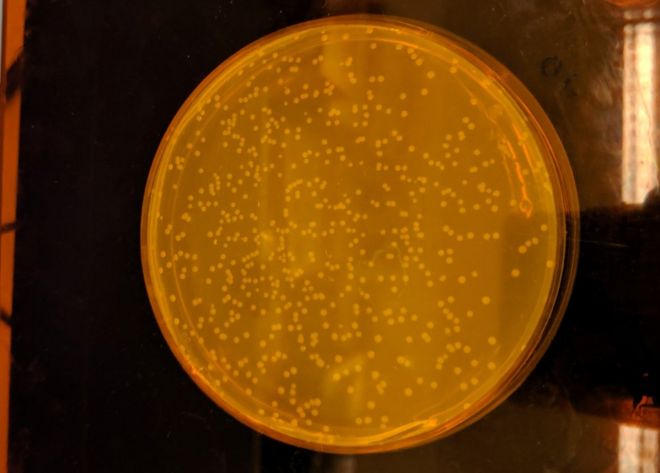Creating life
In a remarkable development with far-reaching consequences, researchers at the Cambridge Laboratory of Molecular Biology have used a computer program to rewrite the DNA of the well-known bacteria Escherichia coli (more commonly known as “E. coli”) to produce a functioning, reproducing species that is far more complex than any previous similar synthetic biology effort.
Venter’s 2010 project
This effort has its roots in a project spearheaded by J. Craig Venter, the well-known maverick biomedical researcher known for the “shotgun” approach to genome sequencing pioneered by his team at Celera Corporation (later acquired by Quest Diagnostics). In May 2010, Venter announced success in his team’s effort to synthesize an organism whose DNA had 1,080,000 DNA base pairs, designed by a computer program. In a final step, Venter reported that the bacteria used this synthetic DNA to generate proteins in preference to those of its own genome.
For additional details, see this Science article and this New York Times report.
The Cambridge Lab project
In the latest advance, researchers at the Cambridge Laboratory of Molecular Biology, led by molecular biologist Jason Chin, constructed a variation of the E. coli bacteria with a synthetically designed genome consisting of four million DNA base pairs, compared with just one million in Venter’s 2010 experiment.
One objective of this study, according to Chin, is to explore why all living organisms on Earth today encode genetic information in the same curious way, and whether this design could be any different yet still yield functioning biology.
In normal biology, each group of three nonoverlapping base pairs code to produce one of 20 amino acids or “stop.” Note that biology could have produced up to 64 amino acids (since 43 = 64), but only 20 are realized in real organisms, because multiple three-base-pair “words” code to the same amino acid, which according to DNA pioneer Francis Crick, may be a “frozen accident” of very early biology. For example, the DNA words CTT, CTC, CTA, CTG, TTA and TTG each code to produce the amino acid leucine, and TCT, TCC, TCA, TCG, AGT and AGC each code to produce serine. In total, 61 of the 64 possible three-base-pair words code to produce amino acids, and three words, namely UAA, UAG and UGA, code “stop.” See this table for details on the DNA code.
Chin’s team decided to try altering the E. coli genome, on the computer, by removing some of the superfluous codons. For example, they replaced all instances of TCG, which codes to serine, with AGC, which also codes to serine. In total, their genome uses just four codons to produce serine instead of six, and uses only two stop codons instead of three. This required editing the E. coli genome in over 18,000 DNA base-pair locations.
The actual implementation of this altered genome was a challenge. The genome is much too long and complicated to insert it into a cell in one attempt. Instead, the researchers swapped in segments, step by step. When they were done, there were only four errors in the four-million-long genome, which were quickly corrected.
The bottom line is that the resulting species is viable and reproduces, but grows somewhat more slowly that standard E. coli and develops longer, rod-shaped cells. Otherwise the cells appear normal. The researchers named the species “Syn61” (see graphic above).
Applications and implications
Chin notes that such “designer lifeforms” could be useful for certain biopharmaceutical applications, for example to make insulin for diabetes patients and drugs for cancer, multiple sclerosis and other conditions. Production lines for these drugs, which employ altered strains of bacteria, are often plagued with viruses, but with designer bacteria of the type that Chin’s team has developed, these production lines could be based on highly virus-resistant artificial bacterial species.
Thomas Ellis, Director of the Center for Synthetic Biology at Imperial College London, described the achievement in glowing terms: “No one’s done anything like it in terms of size or in terms of number of changes before.” Geneticist George Church of Harvard University agrees: “Chin’s success will embolden the rest of us working to make many organisms (industrial microbes, plants, animals, and human cells) resistant to all viruses by this recoding approach.”
There is even the possibility that research like this will ultimately reveal the origin of life, or, at least, the DNA structure of the last universal common ancestor of all present-day species. For example, what is the bare minimum functionality for a species that can make copies of itself?
However this turns out, an era of synthetic biology will soon be upon us. How will we deal with it? Chin acknowledges the challenges:
People have legitimate concerns. … There is a dual use to anything we invent. But what’s important is that we have a debate about what we should and shouldn’t do. And that these experiments are done in a well controlled way.
For additional details, see this New York Times article, this BBC report and this Guardian report. The Cambridge Laboratory’s Nature paper is here.
